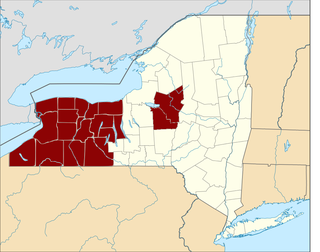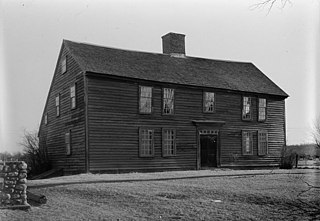Israel Stowell Temperance House | |
Israel Stowell Temperance House | |
| Location | 61-65 E. Walworth Ave. Delavan, Wisconsin |
|---|---|
| Coordinates | 42°38′00″N88°38′56″W / 42.63322°N 88.64898°W Coordinates: 42°38′00″N88°38′56″W / 42.63322°N 88.64898°W |
| Built | 1840 |
| Architect | Israel Stowell |
| Architectural style | Victorian |
| NRHP reference # | 78000145 |
| Added to NRHP | August 11, 1978 |
The Israel Stowell Temperance House was built as an alcohol-free tavern starting in 1840 in the temperance colony of Delavan, Wisconsin. It was added to the National Register of Historic Places in 1978. [1] [2]

The temperance movement is a social movement against the consumption of alcoholic beverages. Participants in the movement typically criticize alcohol intoxication or promote complete abstinence (teetotalism), with leaders emphasizing alcohol's negative effects on health, personality, and family life. Typically the movement promotes alcohol education as well as demands new laws against the selling of alcohols, or those regulating the availability of alcohol, or those completely prohibiting it. During the 19th and early 20th centuries, the temperance movement became prominent in many countries, particularly English-speaking and Scandinavian ones, and it led to Prohibition in the United States from 1920 to 1933.

Delavan is a city in Walworth County, Wisconsin, United States. The population was 8,463 at the 2010 census. It is located 45 miles southwest of Milwaukee. The city is located partially within the Town of Delavan but the two entities are politically independent.

The National Register of Historic Places (NRHP) is the United States federal government's official list of districts, sites, buildings, structures, and objects deemed worthy of preservation for their historical significance. A property listed in the National Register, or located within a National Register Historic District, may qualify for tax incentives derived from the total value of expenses incurred preserving the property.
Delavan was founded in 1836 as a temperance colony by Samuel and Henry Phoenix, reformers who came out of the revivals of the 1820s in the burned-over district of western New York. The brothers were reform-minded Baptists, against slavery and against alcohol, and in the wilds of Wisconsin they planned to start a new community free of these evils. North of Delavan Lake they found their site and on trees there Samuel painted the words "Temperance Colony." They recruited like-minded colonists from back east, and wrote prohibitions against alcohol into the deeds to the land that they sold. In 1839 they started a Baptist church in Delavan true to their values. [3]

The Burned-over District refers to the western and central regions of New York State in the early 19th century, where religious revivals and the formation of new religious movements of the Second Great Awakening took place, to such a great extent that spiritual fervor seemed to set the area on fire.

Baptists are Christians distinguished by baptizing professing believers only, and doing so by complete immersion. Baptist churches also generally subscribe to the tenets of soul competency/liberty, salvation through faith alone, scripture alone as the rule of faith and practice, and the autonomy of the local congregation. Baptists generally recognize two ordinances: baptism and the Lord's supper.
In 1840 the Phoenixes heard about six "temperance houses" - taverns which operated without alcohol - around southeast Wisconsin. They decided that the community of Delvan should have one. They arranged with Israel Stowell to build and operate such a house. Stowell was another immigrant from New York - 27 years old. The Phoenixes provided lumber from their sawmill and some materials. In return, Stowell would operate the inn free of alcohol. [3]
Stowell built the original, central part of the building in the spring of 1840 - a side-gabled saltbox shape; i.e. with two stories exposed in front and one in back. The front door is in Greek Revival style, framed by a heavy molded lintel supported by pilasters. Windows were multi-pane, twelve over eight, and the originals survive in the upstairs of the central section. The framework is hewed oak and walnut beams, connected with mortise and tenon. Inside downstairs is a central staircase with two rooms on either side. The oldest walls are plaster over oak split-lath. Soon after the original construction, Stowell extended the building east three bays, continuing the same design and post and beam construction techniques. Later it was extended another ten feet east, but that section is balloon-framed. [3]

A saltbox house is a traditional New England style of house with a long, pitched roof that slopes down to the back, generally a wooden frame house. A saltbox has just one story in the back and two stories in the front. The flat front and central chimney are recognizable features, but the asymmetry of the unequal sides and the long, low rear roof line are the most distinctive features of a saltbox, which takes its name from its resemblance to a wooden lidded box in which salt was once kept.

A lintel or lintol is a structural horizontal block that spans the space or opening between two vertical supports. It can be a decorative architectural element, or a combined ornamented structural item. It is often found over portals, doors, windows and fireplaces. In the case of windows, the bottom span is instead referred to as a sill, but, unlike a lintel, does not serve to bear a load to ensure the integrity of the wall. Modern day lintels are made using prestressed concrete and are also referred to as beams in beam and block slabs or ribs in rib and block slabs. These prestressed concrete lintels and blocks are components that are packed together and propped to form a suspended floor concrete slab.

A mortiseand tenon joint connects two pieces of wood or of other material. Woodworkers around the world have used it for thousands of years to join pieces of wood, mainly when the adjoining pieces connect at right angles.
True to the agreement, Stowell had the house ready for business in June. It was a community meeting place, with the first town meeting held there in 1842. It was also a haven for outsiders passing on the road west from Racine. [3]
But the temperance colony did not survive. The Phoenix brothers died in the early 1840s. When Stowell left the tavern in the mid 1840s, it was taken over by other innkeepers. In the late 1840s a Mr. Harkness began serving alcohol there. Newer hotels were built in Delavan, and began taking business from the old temperance house. [3]
In 1854 Eliphas Gates bought the building, expanded it, and converted it into three homes for his three children. [4] The bay window was added to the center section later in the 19th century. Around the turn of the century the Victorian addition was added to the west end. [3] Gates descendants lived there for 120 years. [4]
The building has been featured in USA Today.




















